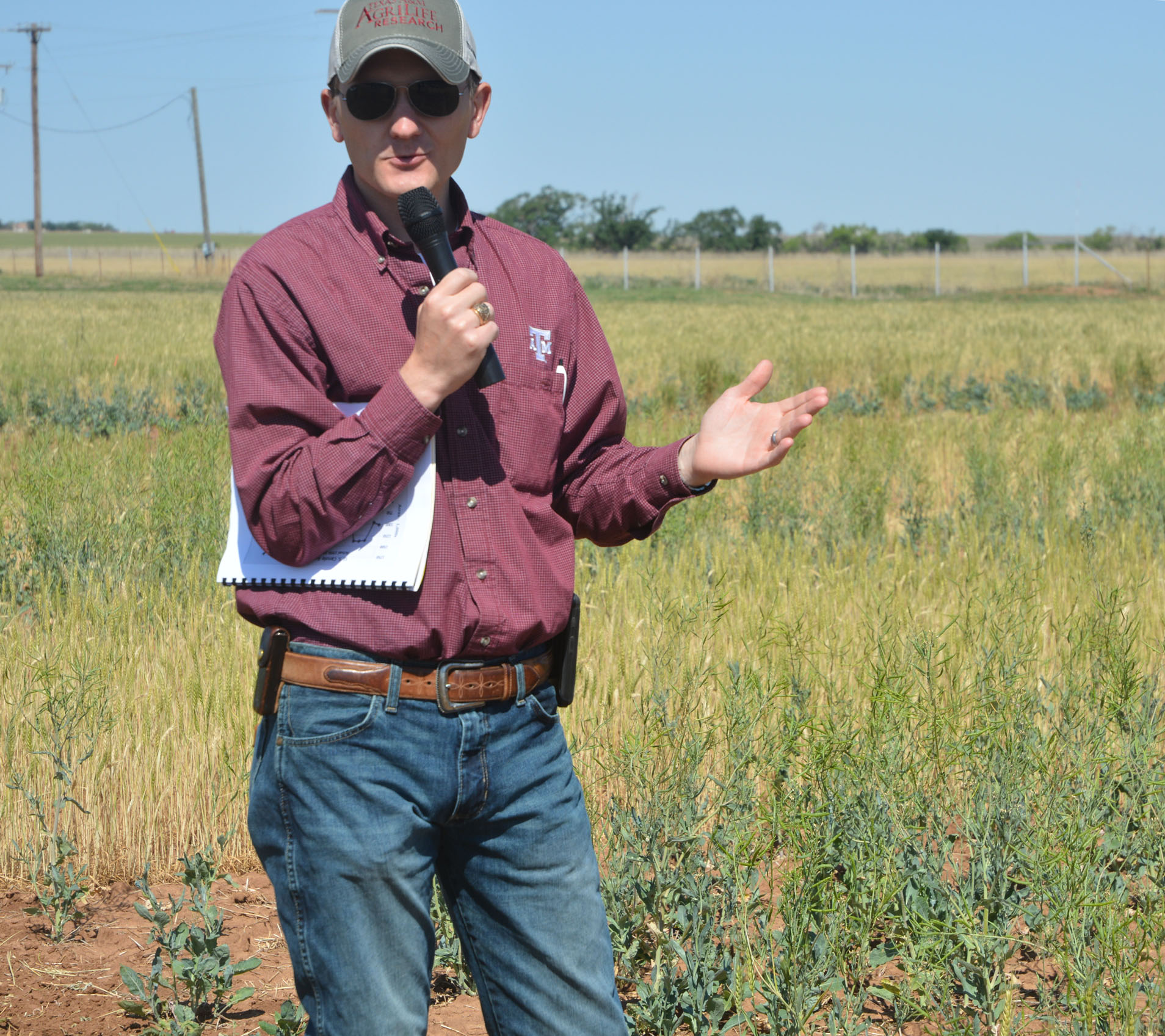Chillicothe, Texas, USA
June 19, 2014
Wheat producers looking for a rotational crop to help clean up weeds and boost yields might find answers with winter canola, according to Texas A&M AgriLife Research and Texas A&M AgriLife Extension Service personnel.

Winter canola can be used in rotation with wheat and help boost yields and clean up weed issues. (Texas A&M AgriLife Research photo by Kay Ledbetter)
Dr. Paul DeLaune, AgriLife Research soil agronomist at Vernon, and Dr. Clark Neely, AgriLife Extension state small grains and oilseed specialist in College Station, discussed winter canola pros and cons at a recent field day near Chillicothe.
“Canola is a higher maintenance crop but also a higher value crop, as much as $2 per bushel higher than wheat, and if you use it as a rotational crop, you can get a higher yield out of your wheat the following years,” DeLaune said.
Canola variety trials have been conducted through the AgriLife Research station at Chillicothe since 2004, consisting of as many as 90 varieties, both experimental and commercial lines.
“Winter canola has received a lot of interest lately,” DeLaune said. “We’ve seen increased acreage in the Rolling Plains and Oklahoma. We are up to about 40,000 acres in Texas, with the majority of acreage within a three-county area of the Rolling Plains.”

Dr. Paul DeLaune, Texas A&M AgriLife Research soil agronomist at Vernon, discusses canola and wheat rotation. (Texas A&M AgriLife Research photo by Kay Ledbetter)
He said the U.S. Canola Association has a goal to increase acreage from the current 400,000 acres to 1.5 million acres by 2018 in the Southern Great Plains, which would include Oklahoma, Kansas, Texas and Colorado.
“Canola is a good rotational crop with wheat,” DeLaune said. “That’s something wheat farmers have struggled with for years, finding rotational crops.”
He said disease and weed pressure can be an issue with continuous wheat systems, which is the predominant practice in the Texas Rolling Plains. With canola, grass-based herbicides can be applied to take care of the grass issues, “so that’s definitely a benefit.”
Additionally, DeLaune said research data from Oklahoma State University shows wheat following canola has as much as a 32 percent increase in tillers; 21 percent increase in forage production and at least a 10 percent increase in wheat grain yields following canola.
Canola is a brassica, a family of crops known to release chemical compounds that may be toxic to soil-borne fungal diseases of plants upon decaying, he said. This biofumigation process can lead to a healthier root system for subsequent grain crops and increased nitrogen use efficiency.
DeLaune’s current study includes continuous wheat, a wheat-canola-wheat rotation and a canola-wheat-wheat rotation to determine agronomic and economic benefits. The project is funded by the Texas Wheat Producers Board.
His other canola studies, funded by the U.S. Department of Agriculture National Institute of Food and Agriculture, include effects of tillage, planting date, row spacing, seeding rate and variety selection on production.
http://youtu.be/mtLl3sTyyMQ
An issue facing canola the past few years has been exceptional drought conditions, he said, which has some farmers waiting to see what the potential production is in this area.
“Those who are adopting canola in the area are typically no-till producers, and an issue they have is maintaining a stand throughout the winter,” DeLaune said.
He said canola’s growing point is above ground. No-till conditions will have more thatch, so the hypocotyl of the plant as it starts to grow is a bit longer, and therefore the growing point is higher and more susceptible to freeze damage.
“We determined planting date and variety selection were the two keys to making a crop this year under some very harsh conditions,” DeLaune said. “Even four or five days made a difference. The optimum planting time is around Sept. 20 in this region. Anything we planted after Oct. 1 had complete winter kill.”

Dr. Clark Neely, Texas A&M AgriLife Extension Service oilseed specialist, discussed canola production considerations. (Texas A&M AgriLife Research photo by Kay Ledbetter)
When selecting a variety, producers will need to consider winter hardiness and the Roundup Ready trait, he said. Another management decision will concern row spacing; most producers are going to 30-inch rows for better residue management for the no-till planter.
Neely said canola tends to be a higher maintenance crop.
“You are almost guaranteed to have some sort of an insect problem and producers need to scout their canola on a regular basis,” he said.
Aphids are the No. 1 pest, including cabbage, green peach and turnip aphids, he said. Diamond back moth larvae can be a concern when the crop is stressed from a drought or freeze because the insect moves down into the crown and does more significant damage. Harlequin bugs, false chinch bugs and flea beetles also can be a problem.
But Neely said there are good products on the market to control most of the insects, including Prevathon, Brigade, Transform and Beleaf.

Insects can be an issue on winter canola. (Texas A&M AgriLife Research photo by Kay Ledbetter)
A couple of other management issues Neely mentioned concern harvest.
“Canola is not like wheat, where you can wait a week or so after it is ready to harvest to get to it,” he said. “When canola is ready to be harvested, you need to have the equipment ready and harvest because it can shatter, unless producers are prepared to swatch prior to harvest.
“It’s also important to have the ideal moisture content – 8-10 percent – at harvest time, because canola is high in oil and does not store very well above that,” Neely said.
Canola does have proven advantages as a rotational crop and producers are making it work, but DeLaune said, “With the conditions we’ve had, drought and a very cold winter, the jury is still out for some about canola and its adoption.”